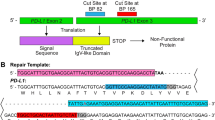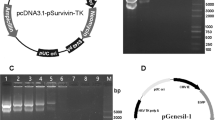Abstract
A major limitation in cancer gene therapy, specifically gene-dependent enzyme prodrug therapy (GDEPT), is inefficient gene delivery and expression. The suicide gene cytosine deaminase (CD) and its substrate, 5-fluorocytosine (5-FC), have been extensively explored due to the inherent ‘bystander’ effect achieved through diffusion of the toxic metabolite 5-fluorouracil (5-FU). In this study, we aimed to enhance this ‘bystander’ effect by fusing the Saccharomyces cerevisiae CD to the HSV-1 tegument protein vp22, a novel translocating protein. Two constructs were created: one with vp22 fused to CD (vp22CD) and a second wherein a truncated vp22, lacking the necessary residues for trafficking, fused to CD (delvp22CD). The generated 9L stable lines exhibited similar growth rates, enzyme expression, CD activity, and sensitivity to 5-FC and 5-FU. However, mixed population colony formation assays demonstrated greater bystander effect with the vp22CD fusion as compared to delvp22CD. This enhancement was maintained in vivo where 9L tumors expressing 20 or 50% vp22CD exhibited increased growth delay compared to the respective delvp22CD tumors. Moreover, adenoviral transduction of established wild-type 9L tumors showed increased growth delay with vp22CD (Ad-EF_vp22CD) as compared to equivalent CD (Ad-EF_CD) transduced tumors. Finally, confirming the increased efficacy, 19F magnetic resonance spectroscopy (MRS) of vp22CD-expressing tumors demonstrated increased 5-FU levels as compared to tumors expressing the nontranslocating CD. These results together demonstrated that fusion of vp22 to CD resulted in CD translocation, which in turn amplified conversion of 5-FC to 5-FU in vivo and enhanced the therapeutic benefit of this GDEPT strategy.
This is a preview of subscription content, access via your institution
Access options
Subscribe to this journal
Receive 12 print issues and online access
$259.00 per year
only $21.58 per issue
Buy this article
- Purchase on Springer Link
- Instant access to full article PDF
Prices may be subject to local taxes which are calculated during checkout






Similar content being viewed by others
References
Kerr DJ, Young LS, Searle PF, McNeish IA . Gene directed enzyme prodrug therapy for cancer. Adv Drug Deliv Rev 1997; 26: 173–184.
Lawrence TS, Rehemtulla A, Ng EY, Wilson M, Trosko JE, Stetson PL . Preferential cytotoxicity of cells transduced with cytosine deaminase compared to bystander cells after treatment with 5-flucytosine. Cancer Res 1998; 58: 2588–2593.
Trinh QT, Austin EA, Murray DM, Knick VC, Huber BE . Enzyme/prodrug gene therapy: comparison of cytosine deaminase/5-fluorocytosine versus thymidine kinase/ganciclovir enzyme/prodrug systems in a human colorectal carcinoma cell line. Cancer Res 1995; 55: 4808–4812.
Mesnil M, Piccoli C, Tiraby G, Willecke K, Yamasaki H . Bystander killing of cancer cells by herpes simplex virus thymidine kinase gene is mediated by connexins. Proc Natl Acad Sci USA 1996; 93: 1831–1835.
Kievit E, Bershad E, Ng E, Sethna P, Dev I, Lawrence TS et al. Superiority of yeast over bacterial cytosine deaminase for enzyme/prodrug gene therapy in colon cancer xenografts. Cancer Res 1999; 59: 1417–1421.
Hamstra DA, Rice DJ, Fahmy S, Ross BD, Rehemtulla A . Enzyme/prodrug therapy for head and neck cancer using a catalytically superior cytosine deaminase. Hum Gene Ther 1999; 10: 1993–2003.
Erbs P, Regulier E, Kintz J, Leroy P, Poitevin Y, Exinger F et al. In vivo cancer gene therapy by adenovirus-mediated transfer of a bifunctional yeast cytosine deaminase/uracil phosphoribosyltransferase fusion gene. Cancer Res 2000; 60: 3813–3822.
Hamstra DA, Lee KC, Tychewicz JM, Schepkin VD, Moffat BA, Chen M et al. The use of (19)F spectroscopy and diffusion-weighted MRI to evaluate differences in gene-dependent enzyme prodrug therapies. Mol Ther 2004; 10: 916–928.
Kambara H, Tamiya T, Ono Y, Ohtsuka S, Terada K, Adachi Y et al. Combined radiation and gene therapy for brain tumors with adenovirus-mediated transfer of cytosine deaminase and uracil phosphoribosyltransferase genes. Cancer Gene Ther 2002; 9: 840–845.
Miyagi T, Koshida K, Hori O, Konaka H, Katoh H, Kitagawa Y et al. Gene therapy for prostate cancer using the cytosine deaminase/uracil phosphoribosyltransferase suicide system. J Gene Med 2003; 5: 30–37.
Tiraby M, Cazaux C, Baron M, Drocourt D, Reynes JP, Tiraby G . Concomitant expression of E. coli cytosine deaminase and uracil phosphoribosyltransferase improves the cytotoxicity of 5-fluorocytosine. FEMS Microbiol Lett 1998; 167: 41–49.
Verma IM, Somia N . Gene therapy – promises, problems and prospects. Nature 1997; 389: 239–242.
Somia N, Verma IM . Gene therapy: trials and tribulations. Nat Rev Genet 2000; 1: 91–99.
McCormick F . Cancer gene therapy: fringe or cutting edge? Nat Rev Cancer 2001; 1: 130–141.
Greco O, Scott SD, Marples B, Dachs GU . Cancer gene therapy: ‘delivery, delivery, delivery’. Front Biosci 2002; 7: d1516–d1524.
Dachs GU, Dougherty GJ, Stratford IJ, Chaplin DJ . Targeting gene therapy to cancer: a review. Oncol Res 1997; 9: 313–325.
Huber BE, Austin EA, Richards CA, Davis ST, Good SS . Metabolism of 5-fluorocytosine to 5-fluorouracil in human colorectal tumor cells transduced with the cytosine deaminase gene: significant antitumor effects when only a small percentage of tumor cells express cytosine deaminase. Proc Natl Acad Sci USA 1994; 91: 8302–8306.
Luft FC . Can VP22 resurrect gene therapy? J Mol Med 1999; 77: 575–576.
Lundberg P, Langel U . A brief introduction to cell-penetrating peptides. J Mol Recognit 2003; 16: 227–233.
Snyder EL, Dowdy SF . Cell penetrating peptides in drug delivery. Pharm Res 2004; 21: 389–393.
Trehin R, Merkle HP . Chances and pitfalls of cell penetrating peptides for cellular drug delivery. Eur J Pharm Biopharm 2004; 58: 209–223.
Elliott G, O'Hare P . Intercellular trafficking and protein delivery by a herpesvirus structural protein. Cell 1997; 88: 223–233.
Martin A, O'Hare P, McLauchlan J, Elliott G . Herpes simplex virus tegument protein VP22 contains overlapping domains for cytoplasmic localization, microtubule interaction, and chromatin binding. J Virol 2002; 76: 4961–4970.
Aints A, Dilber MS, Smith CI . Intercellular spread of GFP-VP22. J Gene Med 1999; 1: 275–279.
Cashman SM, Sadowski SL, Morris DJ, Frederick J, Kumar-Singh R . Intercellular trafficking of adenovirus-delivered HSV VP22 from the retinal pigment epithelium to the photoreceptors – implications for gene therapy. Mol Ther 2002; 6: 813–823.
Elliott G, O'Hare P . Intercellular trafficking of VP22–GFP fusion proteins. Gene Therapy 1999; 6: 149–151.
Elliott G, O'Hare P . Live-cell analysis of a green fluorescent protein-tagged herpes simplex virus infection. J Virol 1999; 73: 4110–4119.
Wybranietz WA, Prinz F, Spiegel M, Schenk A, Bitzer M, Gregor M et al. Quantification of VP22–GFP spread by direct fluorescence in 15 commonly used cell lines. J Gene Med 1999; 1: 265–274.
Phelan A, Elliott G, O'Hare P . Intercellular delivery of functional p53 by the herpesvirus protein VP22. Nat Biotechnol 1998; 16: 440–443.
Dilber MS, Phelan A, Aints A, Mohamed AJ, Elliott G, Smith CI et al. Intercellular delivery of thymidine kinase prodrug activating enzyme by the herpes simplex virus protein, VP22. Gene Therapy 1999; 6: 12–21.
Liu CS, Kong B, Xia HH, Ellem KA, Wei MQ . VP22 enhanced intercellular trafficking of HSV thymidine kinase reduced the level of ganciclovir needed to cause suicide cell death. J Gene Med 2001; 3: 145–152.
Wybranietz WA, Gross CD, Phelan A, O'Hare P, Spiegel M, Graepler F et al. Enhanced suicide gene effect by adenoviral transduction of a VP22-cytosine deaminase (CD) fusion gene. Gene Therapy 2001; 8: 1654–1664.
Kong BH, Wang WX, Liu CS, Ma DX, Qu X . Tegument viral protein 22 enhanced cell-killing effect of the herpes simplex virus thymidine kinase/ganciclovir system on ovarian cancer in vivo. Zhonghua Fu Chan Ke Za Zhi 2003; 38: 195–198.
Qiu Z, Harms JS, Zhu J, Splitter GA . Bovine herpesvirus tegument protein VP22 enhances thymidine kinase/ganciclovir suicide gene therapy for neuroblastomas compared to herpes simplex virus VP22. J Virol 2004; 78: 4224–4233.
Stegman LD, Rehemtulla A, Beattie B, Kievit E, Lawrence TS, Blasberg RG et al. Noninvasive quantitation of cytosine deaminase transgene expression in human tumor xenografts with in vivo magnetic resonance spectroscopy. Proc Natl Acad Sci USA 1999; 96: 9821–9826.
Stevens AN, Morris PG, Iles RA, Sheldon PW, Griffiths JR . 5-fluorouracil metabolism monitored in vivo by 19F NMR. Br J Cancer 1984; 50: 113–117.
Stegman LD, Rehemtulla A, Hamstra DA, Rice DJ, Jonas SJ, Stout KL et al. Diffusion MRI detects early events in the response of a glioma model to the yeast cytosine deaminase gene therapy strategy. Gene Therapy 2000; 7: 1005–1010.
Kievit E, Nyati MK, Ng E, Stegman LD, Parsels J, Ross BD et al. Yeast cytosine deaminase improves radiosensitization and bystander effect by 5-fluorocytosine of human colorectal cancer xenografts. Cancer Res 2000; 60: 6649–6655.
Segota E, Bukowski RM . The promise of targeted therapy: cancer drugs become more specific. Cleve Clin J Med 2004; 71: 551–560.
Aghi M, Hochberg F, Breakefield XO . Prodrug activation enzymes in cancer gene therapy. J Gene Med 2000; 2: 148–164.
Greco O, Dachs GU . Gene directed enzyme/prodrug therapy of cancer: historical appraisal and future prospectives. J Cell Physiol 2001; 187: 22–36.
Freeman SM, Abboud CN, Whartenby KA, Packman CH, Koeplin DS, Moolten FL et al. The ‘bystander effect’: tumor regression when a fraction of the tumor mass is genetically modified. Cancer Res 1993; 53: 5274–5283.
Rehemtulla A, Hamstra DA, Kievit E, Davis MA, Ng EY, Dornfeld K et al. Extracellular expression of cytosine deaminase results in increased 5-FU production for enhanced enzyme/prodrug therapy. Anticancer Res 2004; 24: 1393–1399.
Mullen CA, Kilstrup M, Blaese RM . Transfer of the bacterial gene for cytosine deaminase to mammalian cells confers lethal sensitivity to 5-fluorocytosine: a negative selection system. Proc Natl Acad Sci USA 1992; 89: 33–37.
Wygoda MR, Wilson MR, Davis MA, Trosko JE, Rehemtulla A, Lawrence TS . Protection of herpes simplex virus thymidine kinase-transduced cells from ganciclovir-mediated cytotoxicity by bystander cells: the Good Samaritan effect. Cancer Res 1997; 57: 1699–1703.
Rehemtulla A, Hall DE, Stegman LD, Prasad U, Chen G, Bhojani MS et al. Molecular imaging of gene expression and efficacy following adenoviral-mediated brain tumor gene therapy. Mol Imaging 2002; 1: 43–55.
Lawrence TS . Reduction of doxorubicin cytotoxicity by ouabain: correlation with topoisomerase-induced DNA strand breakage in human and hamster cells. Cancer Res 1988; 48: 725–730.
Acknowledgements
Financial support for this work was provided by NIH Grants P01CA85878, P50CA01014, and R24CA83099, The University of Michigan SPORE in Head and Neck Cancer.
Author information
Authors and Affiliations
Corresponding author
Rights and permissions
About this article
Cite this article
Lee, K., Hamstra, D., Bullarayasamudram, S. et al. Fusion of the HSV-1 tegument protein vp22 to cytosine deaminase confers enhanced bystander effect and increased therapeutic benefit. Gene Ther 13, 127–137 (2006). https://doi.org/10.1038/sj.gt.3302631
Received:
Revised:
Accepted:
Published:
Issue Date:
DOI: https://doi.org/10.1038/sj.gt.3302631
Keywords
This article is cited by
-
VP22 and cytosine deaminase fusion gene modified tissue-engineered neural stem cells for glioma therapy
Journal of Cancer Research and Clinical Oncology (2013)
-
Suicidal gene therapy in the effective control of primary human hepatocellular carcinoma as monitored by noninvasive bioimaging
Gene Therapy (2012)
-
Understanding apoptotic signaling pathways in cytosine deaminase-uracil phosphoribosyl transferase-mediated suicide gene therapy in vitro
Molecular and Cellular Biochemistry (2009)
-
Stem and progenitor cell-mediated tumor selective gene therapy
Gene Therapy (2008)
-
Enhanced effect of microdystrophin gene transfection by HSV-VP22 mediated intercellular protein transport
BMC Neuroscience (2007)



